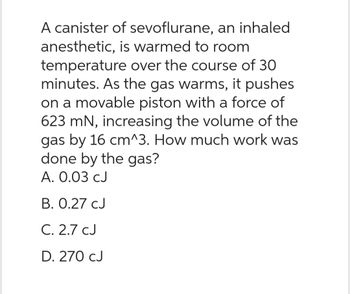
Elements Of Electromagnetics
7th Edition
ISBN: 9780190698614
Author: Sadiku, Matthew N. O.
Publisher: Oxford University Press
expand_more
expand_more
format_list_bulleted
Concept explainers
Question

Transcribed Image Text:A canister of sevoflurane, an inhaled
anesthetic, is warmed to room
temperature over the course of 30
minutes. As the gas warms, it pushes
on a movable piston with a force of
623 mN, increasing the volume of the
gas by 16 cm^3. How much work was
done by the gas?
A. 0.03 CJ
B. 0.27 CJ
C. 2.7 CJ
D. 270 CJ
Expert Solution
This question has been solved!
Explore an expertly crafted, step-by-step solution for a thorough understanding of key concepts.
This is a popular solution
Trending nowThis is a popular solution!
Step by stepSolved in 2 steps

Knowledge Booster
Learn more about
Need a deep-dive on the concept behind this application? Look no further. Learn more about this topic, mechanical-engineering and related others by exploring similar questions and additional content below.Similar questions
- 1. Is it Worth IT? I am considering purchasing a cover for my swimming pool. I have estimated that my pool loses 1.5 in of water off of its 1200 ft² surface each week due to evaporation. The cost of energy to heat the pool averages about $10.00 per million Btu. Interestingly, the salesperson at the pool store claims that a $500 pool cover will reduce evaporative losses by two-thirds and, as such, will pay for itself in one 15-week swimming season. Is it worth it for me to purchase this pool cover? You can assume that the heat of vaporization for water at my pool's average temperature equals 1050 Btu/lb.arrow_forwardSteam generators are a type of heat exchanges that are used in power plants to generate steam at desired pressure and temperature (Fig. Q1.b). In a steam generator, saturated liquid water at 30°C enters a 60-mm diameter tube at the volume flow rate of 12 L/s. After exchanging heat with hot gas, the water changes to steam and leaves the generator at a pressure of 9 MPa and a temperature of 400°C. During this process, the diameter of the water/steam tube does not change.(iii) What is the exit velocity of the steam?arrow_forwardA gas undergoes a constant pressure process at P = 2.4 kPa where the volume increases from 500 I to 1500 I. Determine the change in internal energy if 3000 J of heat is transferred to the system. Oa. 63 kJ Ob. 0.6 kJ OC. 652 kJarrow_forward
- Determine the work done by a kilogram of the fluid system as it expands slowly in a piston-cylinder arrangement from an initial pressure and volume of 550 kPa and 0.028 m3 respectively to a final volume of 0.113 m3in accordance with the following defining relations: a.) p = C; b.) pV = C; c.) pV1.4 = C; d.) p = -730V + 690 kpa where V is in m3arrow_forward74. A 65-kg swimmer pushes on the pool wall and accelerates at 6 m/s. The friction experienced by the swimmer is 100N. What is the magnitude of the force that the swimmer applies on the wall?" - 490 N 490 N O 290 N O : 290 Narrow_forwardA Ford Explorer can refuel with 10 gallons of gasoline in 2 minutes. Given gasoline has an energy content of 13,000 Wh/kg, express this flow of gasoline in terms of energy flow in watts = joules/secarrow_forward
- The wind velocity on the upstream side of a wind turbine is 4 m/s. If the turbine extracts 26% of the available kinetic energy, what is the wind velocity on the downstream side of the turbine in m/s? Please include one decimal place in your answer.arrow_forwardb) Steam generators are a type of heat exchanges that are used in power plants to generate steam at desired pressure and temperature (Fig. Q1.b). In a steam generator, saturated liquid water at 30°C enters a 60-mm diameter tube at the volume flow rate of 12 L/s. After exchanging heat with hot gas, the water changes to steam and leaves the generator at a pressure of 9 MPa and a temperature of 400°C. During this process, the diameter of the water/steam tube does not change. Steam out Gas out Hot gas in Liquid water in Fig 2. Schematic of the steam generator in Q1.b. (i) Calculate the steam mass flow rate (ii) What is the inlet velocity of the steam? (iii) What is the exit velocity of the steam? (iv) Calculate the rate of heat transfer (in MW) required to change the phase of liquid water to steam.arrow_forward
arrow_back_ios
arrow_forward_ios
Recommended textbooks for you
 Elements Of ElectromagneticsMechanical EngineeringISBN:9780190698614Author:Sadiku, Matthew N. O.Publisher:Oxford University Press
Elements Of ElectromagneticsMechanical EngineeringISBN:9780190698614Author:Sadiku, Matthew N. O.Publisher:Oxford University Press Mechanics of Materials (10th Edition)Mechanical EngineeringISBN:9780134319650Author:Russell C. HibbelerPublisher:PEARSON
Mechanics of Materials (10th Edition)Mechanical EngineeringISBN:9780134319650Author:Russell C. HibbelerPublisher:PEARSON Thermodynamics: An Engineering ApproachMechanical EngineeringISBN:9781259822674Author:Yunus A. Cengel Dr., Michael A. BolesPublisher:McGraw-Hill Education
Thermodynamics: An Engineering ApproachMechanical EngineeringISBN:9781259822674Author:Yunus A. Cengel Dr., Michael A. BolesPublisher:McGraw-Hill Education Control Systems EngineeringMechanical EngineeringISBN:9781118170519Author:Norman S. NisePublisher:WILEY
Control Systems EngineeringMechanical EngineeringISBN:9781118170519Author:Norman S. NisePublisher:WILEY Mechanics of Materials (MindTap Course List)Mechanical EngineeringISBN:9781337093347Author:Barry J. Goodno, James M. GerePublisher:Cengage Learning
Mechanics of Materials (MindTap Course List)Mechanical EngineeringISBN:9781337093347Author:Barry J. Goodno, James M. GerePublisher:Cengage Learning Engineering Mechanics: StaticsMechanical EngineeringISBN:9781118807330Author:James L. Meriam, L. G. Kraige, J. N. BoltonPublisher:WILEY
Engineering Mechanics: StaticsMechanical EngineeringISBN:9781118807330Author:James L. Meriam, L. G. Kraige, J. N. BoltonPublisher:WILEY

Elements Of Electromagnetics
Mechanical Engineering
ISBN:9780190698614
Author:Sadiku, Matthew N. O.
Publisher:Oxford University Press

Mechanics of Materials (10th Edition)
Mechanical Engineering
ISBN:9780134319650
Author:Russell C. Hibbeler
Publisher:PEARSON

Thermodynamics: An Engineering Approach
Mechanical Engineering
ISBN:9781259822674
Author:Yunus A. Cengel Dr., Michael A. Boles
Publisher:McGraw-Hill Education

Control Systems Engineering
Mechanical Engineering
ISBN:9781118170519
Author:Norman S. Nise
Publisher:WILEY

Mechanics of Materials (MindTap Course List)
Mechanical Engineering
ISBN:9781337093347
Author:Barry J. Goodno, James M. Gere
Publisher:Cengage Learning

Engineering Mechanics: Statics
Mechanical Engineering
ISBN:9781118807330
Author:James L. Meriam, L. G. Kraige, J. N. Bolton
Publisher:WILEY